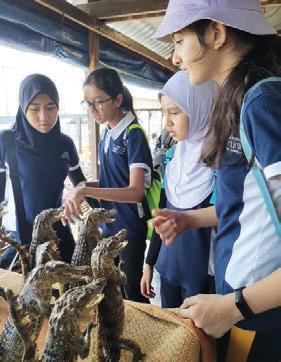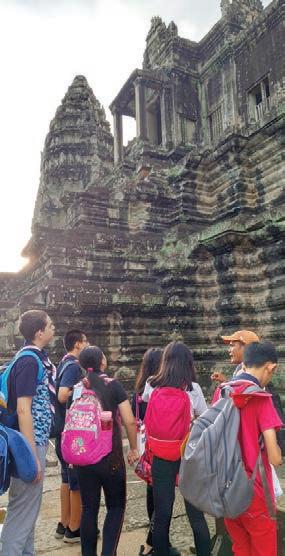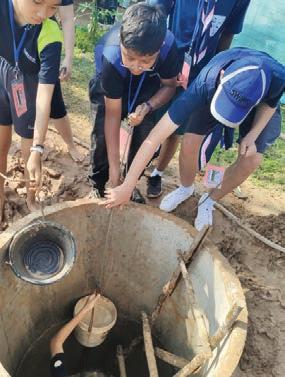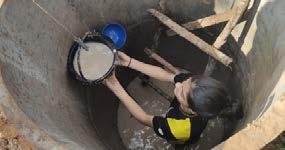
4 minute read
SIEM REAP MYP2
MYP 2
20-24 Oct 2019 55 students + 5 teachers
Advertisement
Trip Leader: Mr Prakash (JB) Assistant Leader: Ms Chee Hui (KL)
SIEM REAP Where history
The Siem Reap expedition with the M2 students was a crazy, memorable and enlightening journey. For me, it was interesting to see how students handle being outside of their comfort zone and apply the values of IB principles in their learning.
There were plenty of opportunities for students to broaden their learning horizons. For example at the Tonle Sap and Floating Village, students analysed and evaluated the consequences of living settlements to the environment. At the magnificent Angkor Wat, students pondered on how the temple complex was constructed with sandstone blocks carried 50 miles away using over hundreds of thousands of workers and ele
WRITER Prakash Balakrishnan phants. Students also got to understand Cambodian culture and heritage by visiting the Artisan d’Angkor and the Silk Factory which highlights the Cambodia arts and craftsmanship.
Possibly the most challenging part of the expedition was the paddy planting and the well digging community project at the Siem Reap countryside.
Our students also travelled to Chrese Orphanage Village to visit the less fortunate children there. Some students took the role of teachers and taught the children languages while rest played football and other games with them.
stays intact

TONLE SAP FLOATING VILLAGE
WRITER SHARIFAH SAFIYYA BINTI SYED MOHD ADEEB
01 02 03 04 Students boarding for a boat ride Students at the crocodile farm Students observing souvenirs in the form of crocodile Students observing the brave local kids holding python
We went to the Tonle Sap Floating Village, the biggest lake in SouthEast Asia. It is called the ‘floating village’, as the houses and other forms of architecture float on the lake. People actually live in these floating villages. During

the trip, we learned new things about the lake, such as its inhabitants, the houses, the power supply, and many more. We learned not just by listening to the tour guide, but also by observing the environment of the lake.
Another thing I have realised was that the people in the Tonle Sap Village have very different lifestyles. They don’t just have different power supply and sewage methods, but they also live in a totally different environment than we do, with lots of greenery and smaller houses. They also lack access to a variety of food cuisines, a good education, and a lot more. They live off water, the flora & fauna around them, while we live off many resources we have easy access to.


01
03

ANGKOR WAT, TA PROHM & BAYON TEMPLE
WRITER LEONG NICK YEUN
01 02 03 The wall carvings at Bayon Temple Steep staircase at Angkor Wat Tourguide explaining the history behind Angkor Wat temple
We went to the Tonle Sap Floating Village, the biggest lake in SouthEast Asia. It is called the ‘floating village’, as the houses and other forms of architecture float on the lake. People actually live in these floating villages. During the trip, we learned new things about the lake, such as its inhabitants, the houses, the power supply, and many more. We learned not just by listening to the tour guide, but also by observing the environment of the lake.
Another thing I have realised was that the people in the Tonle Sap Village have very different lifestyles. They don’t just have different power supply and sewage methods, but they also live in a totally different environment than we do, with lots of greenery and smaller houses. They also lack access to a variety of food cuisines, a good education, and a lot more. They live off water, the flora & fauna around them, while we live off many resources we have easy access to.


01

SERVICE & ACTION: WELL DIGGING
WRITER LIM HUEI QI
01
02
03 Teamwork - students are moving the cement ring to fit into the well Students are removing the excess water from the well before digging further Student digging the soil out of the well
The well digging was part of our service and action where we would take the initiative to contribute to activities that would benefit the locals. In this case, we were requested to help dig a

water well. To dig the well, we had to use a shovel and a bucket to scoop the mud out, after enough dirt was scooped out we had to place a huge cement ring into the hole. There were a total of 5 rings. Unfortunately we only managed to dig the hole deep enough for 1 ring.
From this experience, I learned that well digging was a tough job and that you would need a lot of strength to shove the shovel in the dirt and pull it out. Many of us found it hard at first but we got used to it and by the second day we managed to put a ring into the well but by the end of two days we were enjoying the well digging activity.


01
03







